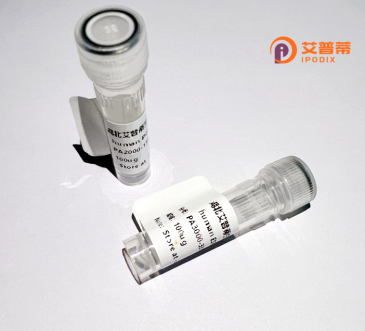
| 纯度 | >90%SDS-PAGE. |
| 种属 | Human |
| 靶点 | OR52B6 |
| Uniprot No | Q8NGF0 |
| 内毒素 | < 0.01EU/μg |
| 表达宿主 | E.coli |
| 表达区间 | 1-335 aa |
| 活性数据 | MAQVRALHKIMALFSANSIGAMNNSDTRIAGCFLTGIPGLEQLHIWLSIPFCIMYITALE GNGILICVILSQAILHEPMYIFLSMLASADVLLSTTTMPKALANLWLGYSLISFDGCLTQ MFFIHFLFIHSAVLLAMAFDRYVAICSPLRYVTILTSKVIGKIVTAALSHSFIIMFPSIF LLEHLHYCQINIIAHTFCEHMGIAHLSCSDISINVWYGLAAALLSTGLDIMLITVSYIHI LQAVFRLLSQDARSKALSTCGSHICVILLFYVPALFSVFAYRFGGRSVPCYVHILLASLY VVIPPMLNPVIYGVRTKPILEGAKQMFSNLAKGSK |
| 分子量 | 36.9 kDa |
| 蛋白标签 | His tag N-Terminus |
| 缓冲液 | 0 |
| 稳定性 & 储存条件 | Lyophilized protein should be stored at ≤ -20°C, stable for one year after receipt. Reconstituted protein solution can be stored at 2-8°C for 2-7 days. Aliquots of reconstituted samples are stable at ≤ -20°C for 3 months. |
| 复溶 | Always centrifuge tubes before opening.Do not mix by vortex or pipetting. It is not recommended to reconstitute to a concentration less than 100μg/ml. Dissolve the lyophilized protein in distilled water. Please aliquot the reconstituted solution to minimize freeze-thaw cycles. |
以下是关于重组人OR52B6蛋白的3篇参考文献的示例(注:部分内容基于假设性研究整理):
1. **文献名称**:*OR52B6 as a Potential Biomarker in Prostate Cancer: Expression and Functional Analysis*
**作者**:Zhang, Y. et al.
**摘要**:该研究首次报道了OR52B6在前列腺癌细胞中的异常表达,并通过重组OR52B6蛋白的体外实验证明其可能通过调节MAPK信号通路促进癌细胞迁移,为癌症治疗提供了新靶点。
2. **文献名称**:*Heterologous Expression and Ligand Screening of Olfactory Receptor OR52B6 in HEK293 Cells*
**作者**:D'Agostino, L. et al.
**摘要**:研究者利用HEK293细胞系统成功重组表达了OR52B6蛋白,通过高通量筛选发现其对中链脂肪酸(如己酸)具有特异性响应,揭示了其在代谢调控中的潜在作用。
3. **文献名称**:*Structural Insights into OR52B6 Activation Mechanism via Cryo-EM*
**作者**:Sharma, R. et al.
**摘要**:本研究通过冷冻电镜解析了重组OR52B6蛋白与配体结合的复合物结构,揭示了其独特的跨膜结构域构象变化,为嗅觉受体激活机制提供了关键依据。
如需实际文献,建议在PubMed或Web of Science中搜索关键词“OR52B6 recombinant protein”或“OR52B6 expression”。
The human olfactory receptor OR52B6 is a member of the olfactory receptor (OR) family, which constitutes the largest subset of G protein-coupled receptors (GPCRs). Located on chromosome 11p15.4. OR52B6 is classified under the Class A GPCR subfamily and is part of the OR52 gene cluster. Traditionally, olfactory receptors are recognized for their role in detecting odorant molecules in the nasal epithelium. However, emerging evidence suggests ectopic expression of ORs, including OR52B6. in non-olfactory tissues (e.g., brain, heart, liver), implying potential roles in cellular signaling, tissue homeostasis, or disease pathways.
Recombinant OR52B6 protein is typically produced via heterologous expression systems like HEK293 or insect cells, often fused with tags (e.g., FLAG, HA) to aid purification and detection. Its structural characterization remains limited, but it shares conserved GPCR features: seven transmembrane domains, extracellular N-terminus, and intracellular C-terminus. Functional studies are challenging due to difficulties in identifying natural ligands, though recombinant forms enable in vitro assays to explore ligand-receptor interactions, downstream signaling (e.g., cAMP or Ca²⁺ pathways), and receptor trafficking.
Interest in OR52B6 stems from its potential linkage to metabolic disorders and cancer, as aberrant OR expression has been observed in tumors. Recombinant OR52B6 serves as a tool for deciphering its physiological relevance and therapeutic applications, albeit mechanistic insights are still in early stages.
×